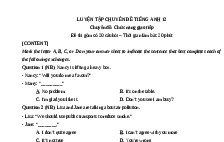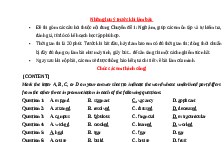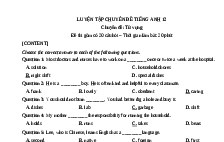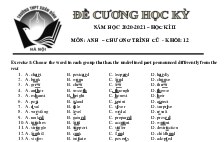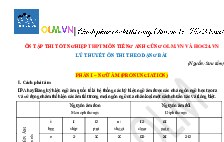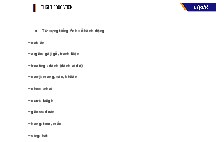Analyzing the Grammar of English
Nội dung tài liệu
Tải xuống
Link tài liệu:
Các tài liệu liên quan
-
![Đề luyện tập Chuyên đề 3: Chức năng giao tiếp]()
-
![Đề luyện tập Chuyên đề 1: Ngữ âm]()
-
![Đề luyện tập Chuyên đề 2: Từ vựng]()
-
![Tài liệu ôn tập HKII năm học 2020-2021 môn Tiếng Anh 12 chương trình cũ, trường THPT Xuân Đỉnh - Hà Nội]()
-
![Lý thuyết ôn thi THPT môn Tiếng Anh theo dạng bài]()
-
![UNDERSTAND]()
-
![TỪ VỰNG VỀ CÁC MÔN HỌC]()
-
![Tuyển tập truyện ngắn song ngữ Anh-Việt hay]()
-
![Tuyển tập truyện cổ tích bằng tiếng Anh]()
-
![TỪ VỰNG VỀ HÀNH ĐỘNG]()
Có thể bạn quan tâm
Thông tin tài liệu
ANALYZING THE GRAMMAR OF ENGLISH00i-xiv.Teschner.FM.indd i00i-xiv.Teschner.FM.indd i4/2/07 6:02:29 PM4/2/07 6:02:29 PMGeorgetown University Press Washington, D.C.Richard V. Teschner and Eston E. EvansAnalyzing the Grammar of EnglishThird Edition00i-xiv.Teschner.FM.indd iii00i-xiv.Teschner.FM.indd iii4/2/07 6:02:31 PM4/2/07 6:02:31 PMAs of January 1, 2007, 13-digit ISBN numbers have replaced the 10-digit system. 13-digit Paperback: 978-1-58901-166-310-digit Paperback: 1-58901-166-XGeorgetown University Press, Washington, D.C.© 2007 by Georgetown University Press. All rights reserved. No part of this book may be reproduced or utilized in any form or by any means, electronic or mechanical, including photocopying and recording, or by any information storage and retrieval system, without permission in writing from the publisher.Library of Congress Cataloging-in-Publication DataTeschner, Richard V.Analyzing the grammar of English Richard V. Teschner and Eston E. Evans.—3rd ed.p. cm.Includes index.ISBN-13: 978-1-58901-166-3 (pbk. alk. paper)ISBN-10: 1-58901-166-X (pbk. alk. paper)1. English language—Grammar. I. Evans, Eston Earl, 1940– II. Title.PE1112.T48 2007425–dc222006031186 This book is printed on acid-free paper meeting the requirements of the American National Standard for Permanence in Paper for Printed Library Materials.14 13 12 11 10 09 08 07 2First printingPrinted in the United States of America00i-xiv.Teschner.FM.indd iv00i-xiv.Teschner.FM.indd iv4/2/07 6:02:32 PM4/2/07 6:02:32 PMvContentsFigures ixAcknowledgments xiIntroduction xiii Utterances, Sentences, Clauses, and Phrases 1The Most Important Parts of Speech 5Noun 5Ve 7Adjective 10Adverb 12Pronoun 13Determiner 14Quantifier 14Preposition 14Case 16Subject Case 17Genitive/Possessive Case 17Object Case and Subject Case 17Sounds: Phones, Phonemes, and Allophones 19Forms: Morphemes and Allomorphs 24/z/—A Highly Productive English Morpheme 25/d/—Another Highly Productive English Morpheme 28Problems with /d/ 29Note 30 Verbs, Tenses, Forms, and Functions 31Conjugating Verb 31Regular Verbs 31Irregular Verbs 32The Nine Morphological Patterns of Irregular Verbs 33Verb Tenses and Auxiliary Verbs: The Nonmodal Auxiliaries (Do, Be, Have) and the Modal Auxiliaries 38The Simple Tenses 38The Importance of the Subject 38Imperatives, the Present Tense, and the Excluded Subject Pronoun 39The Compound Tenses: Present and Past 3900i-xiv.Teschner.FM.indd v00i-xiv.Teschner.FM.indd v4/2/07 6:02:33 PM4/2/07 6:02:33 PMviThe Compound Tenses: Future and Conditional 40Future Tense 41Conditional Tense 41Verb Tenses’ Meanings and Uses 45The Present Tense 46The Past Tense 48The Future and the Conditional Tenses 48The Progressive Tenses: Present/Past/Future/Conditional 50The Perfect Tenses: Present/Past/Future/Conditional 50Notes 54 Basic Structures, Questions, Do-Insertion, Negation, Auxiliaries, Responses, Emphasis, Contraction 55The Five Basic Structures 55Two Different Types of Questions 55Do-Insertion 55Negation 56The Role of the First Auxiliary (aux) 56Nonmodal Auxiliaries Be/Do/Have Can also Be Used as Lexical Verbs 57Wh-Words as Subjects vs. Wh-Words as Objects 58Selection Questions 63Declarative Questions 63Echo Questions 64Tag Questions 64Invariant Tags 65Elliptical Responses 65Emphasis and Emphatic Structures 68Contractions: Summing Up 71Contracting Not 71Nonmodal Auxiliaries’ Contractions 71Modal Auxiliaries’ Contractions 74Note 77 Modals, Prepositional and Particle Verbs, Transitivity and Voice, and Conditionality 79Modals and Perimodals 79Perimodals 81The Meanings of Modals and Perimodals 82Two-Word Verbs: Prepositional Verbs vs. Particle Verbs 89General Comments about Prepositional vs. Particle Verbs 92Transitivity: Active Voice, Passive Voice 95Intransitive Verbs and “Voice” 100Transitive Verbs in Superficially Intransitive Constructions 100Normally Transitive Verbs used Intransitively 101Real-World Use of the English Passive: Pragmatic Constraints and Agent Phrase Addition 103GET Passives 104Conditionality 106Contents00i-xiv.Teschner.FM.indd vi00i-xiv.Teschner.FM.indd vi4/2/07 6:02:35 PM4/2/07 6:02:35 PMvii Some Components of the Noun Phrase: Forms and Functions 113Person and Number 113Gender 113Case 114Expressing Possession: Genitives and Partitives 116Partitive-Genitive Constructions 117Determiners, Common/Proper Nouns, and Mass/Count Nouns 121Determiners 121Articles, Definiteness, and Specificity 121Common and Proper Nouns 123Mass Nouns and Count Nouns 123Mass-to-Count Shifts 124Dual-Function Nouns: Nouns That Are Both Mass and Count 125Pronouns 128The Morphology of Personal Pronouns 131Reflexive Pronouns 131Reciprocal Constructions 132Demonstratives 135Demonstrative Pronouns 136Indefinite Pronouns 137Relative Pronouns 138Interrogative Pronouns 139Pro-Words: Pronoun-Like Words for Clauses, Phrases, Adjectives, and Adverbs 140Note 142 Adjectives and Relative Clauses 143Attributive and Predicate Adjectives: Identification and Syntax 143The Syntax of Prenominal Attributive Adjectives 147Adjectives and Adverbs: Comparative and Superlative Forms 148Changing Equatives to Comparatives: When to Use More and When to Use -er 148The Morphology of Superlatives: When to Use -est and When to Use Most 150Equatives, Comparatives, and Superlatives: Their Structures and Meanings 150Equatives with Comparative Meanings and Equatives and Comparatives with Superlative Meanings 153Relative Clauses, Relative Pronouns, and Their Antecedents 155When to Use Who and When to Use Whom 157Deleting Relative Pronouns: Creating Gaps and the Process of Gapping 157The Twenty Types of Relative Clauses 158How to Use the Example Sentences in Figure 6b 158The Relativization of the Possessive Determiner Whose 159Restrictive and Nonrestrictive (Relative) Clauses 165Relative Pronoun Clauses with Present Participles/Gerunds and with Past Participles 168Notes 170 Adverbs, It and There Referentials and Nonreferentials, and Fronting 171Adverbs 171It as Referential, It as Nonreferential 174 Contents00i-xiv.Teschner.FM.indd vii00i-xiv.Teschner.FM.indd vii4/2/07 6:02:36 PM4/2/07 6:02:36 PMviiiAdverb Referential There, Existence-Marking Nonreferential There 175Emphasis by Peak Stressing, Solo Fronting, or Cleft Fronting 178Note 182 Compound Sentences: Coordination, Subordination 183Compound Sentences 183Coordinate Sentences 183Subordinate Sentences 188Clausal Adverb Complements 190Clausal Object or Subject Complements 191Clausal Predicate Nominative Complements 192Clausal Noun Complements 192Clausal Adjective Complements 193Tenseless Complements 195Infinitives and Gerunds as Tenseless Verb Complements 195The That-Clause 197The Infinitive Complement 197Equi-Deletion 198Raising to Object 198Infinitive Complement with Equi-Deletion 198Infinitive Complement with Raising to Object 199Gerund Complement 201Gerund Complement with Equi-Deletion 201Gerund Complement with Raising to Object 201Gerund Complement with Raising to Possessive 202Purpose Complements 203Miscellaneous Complementation Patterns 204Summary of All Clausal Complementation Patterns 204Appendix 211Glossary of Terms 219Index 229Contents00i-xiv.Teschner.FM.indd viii00i-xiv.Teschner.FM.indd viii4/2/07 6:02:37 PM4/2/07 6:02:37 PMixFigures 1a Utterance, Sentence, and Clause 1b The Twelve English Vowel Phonemes 20 1c Words Exemplifying the English Vowel Phonemes’ Sounds 21 1d Correlation of Stress and Schwa 21 1e Voiceless and Voiced Consonant Pairs 22 1f The Twenty-Four English Consonant Phonemes 22 2a The Fourteen Active Voice Compound (and the Two Simple) Verb Tenses 42 3a Presence of do-Insertion 56 3b Absence of do-Insertion 57 3c Tag Questions: The Tree 65 3d Tag Questions: The Outline 65 3e Tag Questions: The Examples and the Explanations 66 4a The Perimodals 81 4b The Eight Modality Types and Their Representative Modal Verbs 83 4c Simple and Compound Tenses in the Passive Voice 96 4d The Syntax of GET Passives and BE Passives 104 4e The Various Types of Conditionality 107 5a Grammatical Gender: English Compared with Spanish 114 5b Genitive versus Partitive in Expressions of Possession 115 5c The Mass Noun/Count Noun Distinction: Potential Environments 126 5d The English Personal Pronoun System 130 5e The English Demonstratives 136 6a The Ordering of Prenominal Attributive Adjectives 147 6b The Twenty Types of Relative Clauses 159 7a Different Ways of Expressing Emphasis 179 8a The Structure of Coordinate Sentence 189 8b The Structure of Subordinate Sentence 189 8c The Structure of Multiple Complementing with that-Clauses 191 8d The Structure of an Equi-Deletion 198 8e Equi-Deletion Complements in the Passive Voice 199 8f Infinitive Complement with Raising to Object 20000i-xiv.Teschner.FM.indd ix00i-xiv.Teschner.FM.indd ix4/2/07 6:02:38 PM4/2/07 6:02:38 PMTrên đây chỉ là phần trích dẫn 10 trang đầu của tài liệu và có thế hiển thị lỗi font, bạn muốn xem đầyđủ tài liệu gốc thì ấn vào nút Tải về phía dưới.


